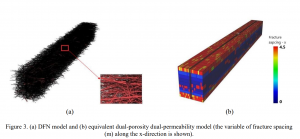Numerical Simulation of Shale Gas Production and Fracturing Fluid Distribution: Integration of Apparent Permeability and Secondary Fracture Network Modeling
Abstract
Complex flow mechanisms are encountered in shale matrix due to the presence of nanopores. Numerous apparent permeability models have been proposed to capture the ensuing non-Darcy flow behavior. However, these models are not readily available in most commercial reservoir simulators, and ignoring these mechanisms can potentially underestimate the overall matrix conductivity. During the hydraulic fracturing process, the fracturing fluid may cause water blockage, if the nearby secondary fractures subsequently close and get disconnected due to changes in effective stress distribution during flowback and production. The circumstances and detailed mechanisms associated with this phenomenon are still poorly understood. This work implements an explicit coupling strategy for integrating a pressure-dependent apparent permeability model and a dynamic secondary fracture closure process in the reservoir simulation. The numerical models are subsequently used to study the impacts of apparent permeability modeling, secondary fracture distributions and water blockage on gas production and water loss; the impacts of multiphase flow functions and shut-in durations on fluid retention are assessed.
A set of 3D reservoir models are constructed based on data obtained from the Horn River shale gas reservoir. A stochastic 3D discrete fracture network (DFN) model are upscaled into equivalent continuum dual-porosity dual-permeability (DPDK) models. An apparent permeability (Kapp) model accounting for the contributions of Knudsen diffusion, slip flow and surface pore roughness is applied at each grid block. In order to capture the pressure dependency, a novel coupling scheme is formulated to facilitate the updating of Kapp and effective stress after a certain designated time interval. In addition, a novel method involving rock-type indicators is introduced to represent the open and closed states of secondary fractures, facilitating the modeling of stress-dependent closure of the secondary fracture system.
The results reveal that incorporating these additional flow mechanisms via the apparent permeability formulation could potentially increase the overall gas production prediction by up to 12%, depending on the matrix or fluid properties; ignoring Kapp modeling could overestimate water recovery. Fracture closure and the resulting water blockage would reduce the gas production but enhance the water recovery. The implications of Kapp and fracture closure modeling in water-loss mechanisms are further examined through a set of sensitivity analyses.
A few interesting findings are observed: (1) the extent to which the fracturing fluid could imbibe into the matrix is mainly affected by the secondary fracture connectivity; an increase in secondary fracture intensity may enhance water loss; (2) except for an increase in the matrix gas relative permeability, gas and water productions are typically inversely related to the amount of water in the near-well region; (3) in a gas-water system, compressibility of the in-situ fluids renders the effects of counter current imbibition and water retention to be more complex from those observed in water-oil systems; (4) in the presence of disconnected secondary fractures, gas production would be improved with less water imbibition into the matrix, while a shorter shut-in period may be beneficial to both water and gas recovery. These results have offered several interesting insights regarding the potential implications on fracturing design and estimation of stimulated reservoir volume.


